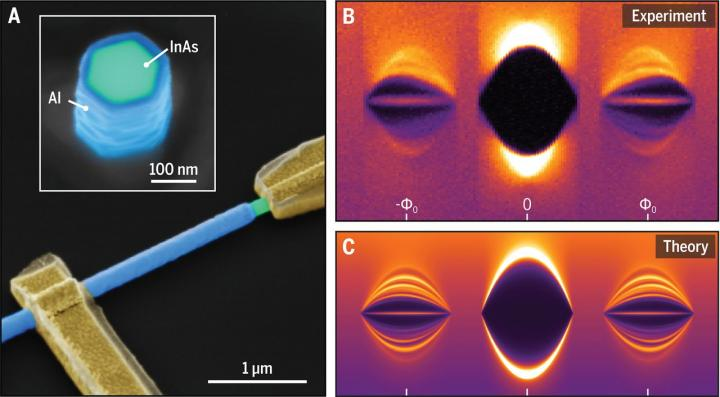Apr 23 2020
Researchers at the Center for Quantum Devices, Niels Bohr Institute, of the University of Copenhagen, used a pencil-shaped semiconductor, with a diameter of only a few hundred nanometers, to unravel a new path to Majorana zero modes and topological superconductivity.
 Hybrid material nanowires with pencil-like cross section (A) at low temperatures and finite magnetic field display zero-energy peaks (B) consistent with topological superconductivity as verified by numerical simulations (C). Image Credit: Niels Bohr Institute.
Hybrid material nanowires with pencil-like cross section (A) at low temperatures and finite magnetic field display zero-energy peaks (B) consistent with topological superconductivity as verified by numerical simulations (C). Image Credit: Niels Bohr Institute.
The researchers achieved this by collaborating with Microsoft Quantum researchers, and the study was reported recently in the Science journal.
The new path found by the team involves using the phase winding around the circumference of a cylindrical superconductor that surrounds a semiconductor. This method is termed “a conceptual breakthrough.”
The result may provide a useful route toward the use of Majorana zero modes as a basis of protected qubits for quantum information. We do not know if these wires themselves will be useful, or if just the ideas will be useful.
Charles Marcus, Villum Kann Rasmussen Professor, Niels Bohr Institute
Marcus is also the Scientific Director of Microsoft Quantum Lab in Copenhagen.
“What we have found appears to be a much easier way of creating Majorana zero modes, where you can switch them on and off, and that can make a huge difference.”
Saulius Vaitiekenas, Study Lead Experimentalist and Postdoctoral Research Fellow, Niels Bohr Institute
Two Known Ideas Combined
The new study combines two well-known concepts used in the realm of quantum mechanics: one-dimensional topological superconductivity in nanowires and vortex-based topological superconductors.
The significance of this result is that it unifies different approaches to understanding and creating topological superconductivity and Majorana zero modes.
Karsten Flensberg, Professor and Director, Center for Quantum Devices, Niels Bohr Institute
When looking back in time, the study outcomes can be outlined as an extension of a 50-year old physics phenomenon called the Little-Parks effect. As part of the Little-Parks effect, a cylindrical-shell-shaped superconductor adapts to an external magnetic field, threading the cylinder by shifting to a “vortex state” in which the quantum wavefunction surrounding the cylinder includes a twist in phase.
The researchers required a unique type of material that integrated superconducting aluminum and semiconductor nanowires. These materials were created in the Center for Quantum Devices in recent years.
The specific wires for this research were unique in that they had a superconducting shell completely surrounding the semiconductor. These were developed by professor Peter Krogstrup, also at the Center for Quantum Devices and Scientific Director of the Microsoft Quantum Materials Lab in Lyngby.
The study is the outcome of the same fundamental scientific intuitiveness that has resulted in several great discoveries through history.
“Our motivation to look at this in the first place was that it seemed interesting and we didn’t know what would happen,” stated Charles Marcus, speaking about the experimental finding, which was theoretically confirmed in the same publication. However, the concept may point to a path forward for quantum computing.